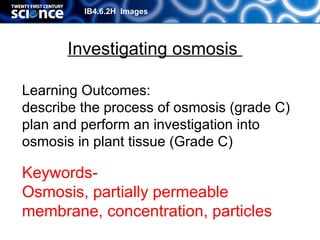B4 06-2 h investigating osmosis
- 1. IB4.6.2H Images Investigating osmosis Learning Outcomes: describe the process of osmosis (grade C) plan and perform an investigation into osmosis in plant tissue (Grade C) Keywords- Osmosis, partially permeable membrane, concentration, particles ┬® Oxford University Press 2011
- 2. IB4.6.2H Images why water is so important to cells/living things? What happens if people do not have enough water? *You should be able to answer these questions using scientific ideas and keywords ┬® Oxford University Press 2011
- 3. IB4.6.2H Images Potato slices or cylinders are used as models for plant cells in this investigation Suggest how you could find out whether the potato gained or lost water *The mass at the start and end can be used as the dependant variable ┬® Oxford University Press 2011
- 4. IB4.6.2H Images Set up osmosis activity 1 from Activity AB4.6.1 Diffusion and osmosis, to give time for osmosis to have an effect. *We carried out this investigation using the potato slices and sucrose ┬® Oxford University Press 2011
- 5. IB4.6.2H Images Diagrams a and b show how water molecules move during osmosis. In this example the membrane allows water through but the glucose molecules are too big to get through ┬® Oxford University Press 2011
- 6. IB4.6.2H Images Findings from the experiment and interpret the changes in terms of water moving in and out of cells by osmosis. plant cells have rigid cell walls, so are fairly robust. However, animal cells burst or shrink due to osmosis. class results do they show a trend? potato cylinders in pure water increase in mass; in very sugary solutions their mass will decrease. Outlying measurements that are outside the trend line may be incorrect. Identify outliers. What should happen to the outliers? ┬® Oxford University Press 2011
- 7. IB4.6.2H Images The photographs show the same plant. In the right hand image, the plant is shown after it has not been watered for 10 days. Notice how the structure has changed as the plant cells have dried. ┬® Oxford University Press 2011
- 8. IB4.6.2H Images Observe osmosis in action using Video IB4.6.4 Paramecium and complete Osmosis activities 2 and 3 from Activity AB4.6.1 Diffusion and osmosis. Complete second measurement of potato cylinders for osmosis activity 1 and complete table of results *Recall the outcome of the investigation: in water alone (as a control), the potatoes gained mass, in sucrose solution they lost mass, you should be able to explain this using keywords and scientific ideas ┬® Oxford University Press 2011
- 9. IB4.6.2H Images 1.The normal blood cells are rounded and bi-concave, whereas the abnormal cells are irregular/spiked. 2. The diameter is about 6ŌĆō7 ┬Ąm. 3. As the salt concentration of the solution increases, the diameter of the red blood cells decreases. 4. The red blood cells are losing water by osmosis, causing the cells to shrink. 5. 0.45ŌĆō0.65 g/cm3 (depending on the estimate of diameter from question 2). This is the concentration where the cells have a ŌĆśnormalŌĆÖ diameter, so are not gaining or losing water by osmosis. 6. They have swollen and burst. *Answers to questions set about blood cells and osmosis (worksheet) ┬® Oxford University Press 2011
Editor's Notes
- #6: Diagrams a and b below show how water molecules move during osmosis. In this example the membrane allows water through but the glucose molecules are too big to get through.
- #8: The photographs show the same plant. In the right hand image, the plant is shown after it has not been watered for 10 days. Notice how the structure has changed as the plant cells have dried. Biophoto Associates/Science Photo Library








